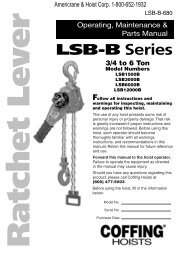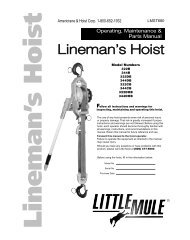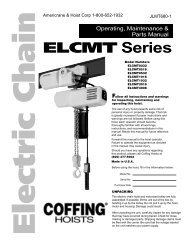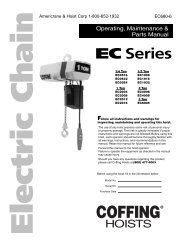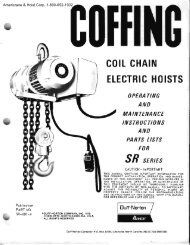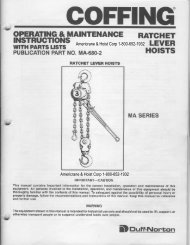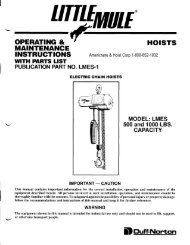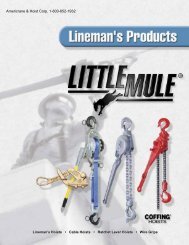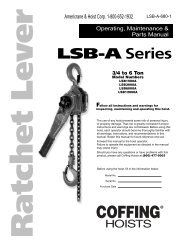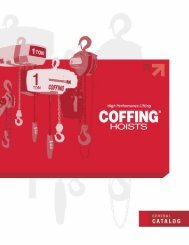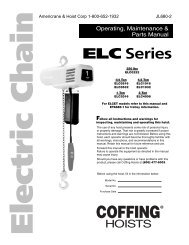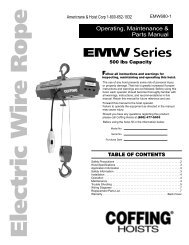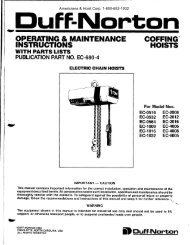JLC Series, JLC680 - Coffing Hoists, Coffing Hoist Parts
JLC Series, JLC680 - Coffing Hoists, Coffing Hoist Parts
JLC Series, JLC680 - Coffing Hoists, Coffing Hoist Parts
You also want an ePaper? Increase the reach of your titles
YUMPU automatically turns print PDFs into web optimized ePapers that Google loves.
Country Club Road<br />
P.O. Box 779<br />
Wadesboro, NC 28170 USA<br />
TEL: (800) 477-5003<br />
FAX: (800) 374-6853<br />
Bearings<br />
All bearings except hook and idler sheave bearings are<br />
lubricated at the factory and should not require additional<br />
lubrication. Noisy or worn bearings should be replaced.<br />
Limit Switch Shaft<br />
Remove any dirt accumulation and spray with a general<br />
purpose lubricant.<br />
Hook Bearing<br />
Apply a few drops of SAE 30 gear or motor oil around the edge<br />
of the bearing.<br />
Idler Sheave Bearing (Bushing)<br />
Disassemble load block and apply a light coat of NLGI #2<br />
grease, or equivalent, inside of bearing.<br />
HOIST REPAIRS<br />
1. For major repairs or when the hoist is to be sectioned in the<br />
suspension area, it will be necessary to move the hoist to a<br />
workbench or table.<br />
2. For repairs which can be done by removing the electrical<br />
cover only, the hoist need not be moved. Lowering the hoist<br />
to a convenient working level is desirable.<br />
NOTE: If you do not have an experienced mechanic to do your<br />
repair work, we recommend that you send your hoist to an<br />
approved service station for repairs. Use authorized repair<br />
parts only.<br />
Remove load and disconnect hoist from power supply<br />
before starting to do any repairs or to take any<br />
sections apart.<br />
The following repair instructions will help you in understanding<br />
repair procedures, when related to the Replacement <strong>Parts</strong><br />
List starting on page 18. For clarity these are broken down<br />
into areas.<br />
Electrical <strong>Parts</strong> and Brake<br />
1. Refer to Figures 15, 16 and 17. Remove the cover to access<br />
the controls. Single-phase models also have a starting switch<br />
and capacitor mounted on the panel as shown in Figure 16.<br />
The terminal blocks and end clamps snap off of the rails on<br />
the plate using a small screwdriver. DO NOT SLIDE THE END<br />
CLAMPS.<br />
The reversing contactor can be slid off the rail, but it must be<br />
snapped on. Where the contactor fits the rail, one side has<br />
springs or pads that apply pressure against the edge of the<br />
rail. By pressing against that side at the base of the contactor,<br />
you can snap the part on or off using a rotating action. Note<br />
the numbers that label the terminals on the contactor and<br />
orient the part as shown in Figures 9A-9D. Single-phase<br />
contactors have a small jumper that is not present on the<br />
3-phase (note the 3 and 5 terminals on the reversing<br />
contactor in Figure 9A).<br />
2. Remove the electrical panel by removing the stand-off<br />
screws (See Figures 16 & 17). The limit switch and brake are<br />
now accessible as shown in Figure 6.<br />
3. Remove the transformer bolted to the back of the panel plate<br />
if it requires replacement.<br />
4. Refer to Figure 15 to disassemble the brake. See BRAKE<br />
ADJUSTMENT on page 9 to properly set the brake.<br />
Figure 6 - Electrical Panel Removed<br />
5. Refer to Figures 20 and 21 to disassemble the limit switch.<br />
See LIMIT SWITCH ADJUSTMENT on page 8 to properly<br />
set the upper and lower limits of travel.<br />
6. Refer to Figures 18 and 19 for repairs on the pushbutton<br />
station. Also refer to the wiring diagram inside the electrical<br />
cover or Figures 9A, 9B, 9C and 9D for wiring instructions.<br />
Motor<br />
Refer to Figures 12, 13 and 14.<br />
The hoist motor is located on the opposite end to that of the<br />
electrical parts, but the two are tied together with electrical<br />
leads running through the housing.<br />
1. If it is necessary to replace or repair the motor,<br />
DISCONNECT THE HOIST FROM THE POWER SUPPLY<br />
and remove the electrical cover.<br />
2. Loosen the screw clamps on the terminal blocks and<br />
reversing contactor to disconnect the motor leads<br />
(See Figures 16 and 17).<br />
3. Remove the four motor mounting bolts attaching the motor<br />
to the housing. It will come loose at the motor coupling.<br />
4. Inspect the motor coupling, motor shaft and all the bearings.<br />
Replace as necessary.<br />
5. Install new or repaired motor according to the wiring diagram<br />
located inside the electrical cover or Figures 9A, 9B, 9C<br />
and 9D.<br />
Gearing<br />
Refer to Figures 7, 12 and 22.<br />
As disassembly is extensive for gearing, disconnect the hoist<br />
and move it to a workbench.<br />
1. Remove the electrical cover.<br />
2. Remove the electrical panel.<br />
3. Remove the brake assembly and the limit switch assembly.<br />
4. Drain the oil from the transmission.<br />
5. Remove the four screws that attach the transmission cover<br />
to the gear housing and remove the transmission cover. The<br />
limit switch drive shaft will come along with the cover.<br />
Do not disassemble or readjust the clutch, or replace<br />
it with a clutch assembly from another hoist. Doing so<br />
will void the warranty and may create an unsafe<br />
condition. If replacement is needed due to wear or<br />
loss of adjustment, always use a new clutch assembly.<br />
10



